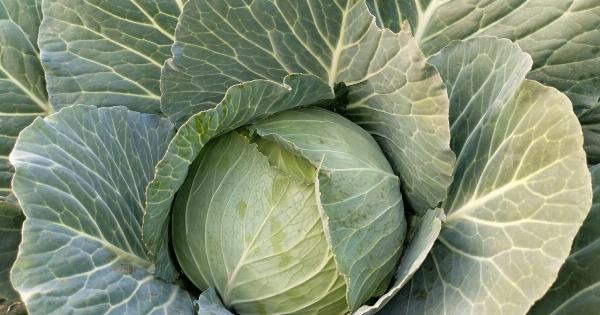When we think of cabbage, we often envision delicious coleslaw or a hearty stew ingredient. However, cabbage’s importance extends far beyond mere culinary delights.
This unassuming vegetable has found its way into various branches of modern science, offering unique and surprising contributions. From nutrition to medicine, let’s explore the unexpected role of cabbage in pushing the boundaries of scientific discovery.
The Nutritional Powerhouse
Cabbage is renowned for its nutritional benefits. Packed with essential vitamins and minerals, it has become increasingly important in promoting overall health and well-being. Its high fiber content supports digestion and helps prevent constipation.
Loaded with vitamin C, cabbage boosts the immune system and promotes collagen production for healthy skin.
Beyond these well-known benefits, cabbage contains various phytochemicals that have sparked scientific interest.
These compounds, such as glucosinolates and flavonoids, have antioxidant properties that may help reduce the risk of chronic diseases, including certain types of cancer and cardiovascular issues. Researchers continue to investigate cabbage’s potential in preventing and managing these serious conditions.
Cabbage: A Tool for Environmental Studies
As concerns about environmental pollution grow, scientists are searching for innovative ways to monitor and mitigate the impact of human activity.
Surprisingly, cabbage has emerged as a useful tool in environmental studies, particularly when it comes to air pollution research.
Cabbage leaves are excellent bioindicators, meaning they change visibly in response to environmental alterations. This characteristic makes them invaluable in detecting air pollution levels, including heavy metals and particulate matter.
By analyzing the cabbage leaves’ changes, scientists can assess air quality in a given area and devise targeted strategies to improve it. Cabbage’s unsuspecting role in environmental research offers new possibilities for understanding the environmental challenges we face.
Cabbage in Medical Research
Medical researchers are known for their relentless pursuit of breakthrough treatments and therapies. In recent years, cabbage has caught their attention due to its potential applications in medicine.
Preliminary studies have shown promising results in using cabbage as a wound-healing agent.
Cabbage poultices have long been used as a traditional remedy for skin conditions and minor wounds. Modern research confirms that cabbage possesses anti-inflammatory properties and aids in tissue regeneration.
In fact, the leaves of specific cabbage varieties can accelerate the healing process and mitigate pain. Further exploration of cabbage’s compounds may lead to the development of advanced wound dressings and novel approaches to healing difficult wounds.
Cabbage and Microbiology
Microbiology, the study of microorganisms, has greatly benefitted from cabbage’s versatility. Cabbage serves as an ideal medium for cultivating bacteria and fungi in laboratory settings.
Its natural pH and nutrient composition promote the growth of various microorganisms, making it an invaluable tool in microbiological research.
Scientists use cabbage as a growth medium to culture microorganisms and study their characteristics.
This approach helps microbiologists understand how various microorganisms interact, potentially leading to breakthroughs in disease prevention, antibiotic research, and biotechnology. Cabbage’s role as a microorganism cultivation medium highlights its significance in furthering scientific knowledge.
Cabbage: Fueling Genetic Research
Genetic research has seen tremendous progress in recent decades, leading to groundbreaking discoveries and advancements in various fields. In this era of genomics, cabbage has found a niche as an essential resource in genetic studies.
Cabbage’s genetic diversity is unparalleled among vegetables, making it an invaluable model organism for plant geneticists. Its relatively small genome size and ease of manipulation enable researchers to investigate complex genetic traits.
Scientists have unraveled key genetic mechanisms, such as flowering time and disease resistance, by studying cabbage’s genome.
Moreover, cabbage’s close relationship with other cruciferous vegetables, such as broccoli and cauliflower, allows researchers to gain insights into the genes and traits shared among these plants.
Understanding cabbage’s genetics unlocks new paths for developing improved crop varieties, enhancing food security, and advancing agricultural practices.
The Culinary Influence of Cabbage
While modern science has revealed many surprising roles for cabbage, its culinary value must not be overlooked. Cabbage is a versatile ingredient that adds texture, flavor, and nutrition to a wide range of dishes.
From sauerkraut in Eastern Europe to kimchi in Korea, fermented cabbage has long been a staple of various traditional cuisines. Fermentation not only preserves cabbage but also enhances its nutritional profile.
Fermented cabbage products contain probiotics, which support a healthy gut microbiome and promote digestion.
Additionally, cabbage’s adaptability allows it to be prepared in various ways—cooked, raw, stir-fried, or steamed. Its mild flavor pairs well with different seasonings and ingredients, making it a favorite choice for chefs and home cooks alike.
Whether used as a crunchy salad base or a flavorful stuffing, cabbage’s culinary influence enriches our gastronomic experiences.
Exploring Cabbage’s Potential
The surprising role of cabbage in modern science goes beyond what meets the eye.
From its nutritional value to its contributions within medical, environmental, microbiological, and genetic research, cabbage continues to amaze and inspire scientists worldwide. As we delve deeper into understanding this unassuming vegetable, the possibilities for its applications in various scientific realms are endless.





























